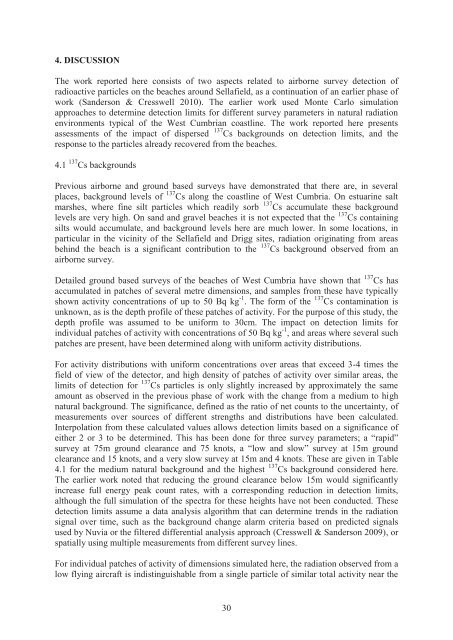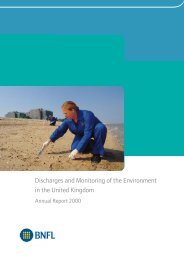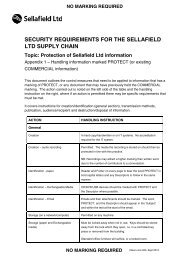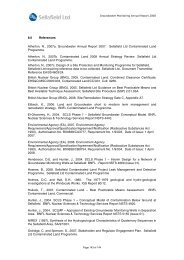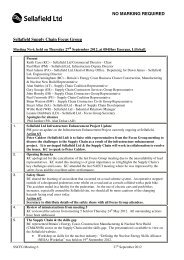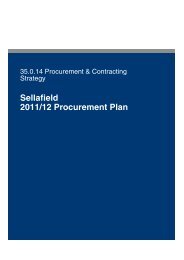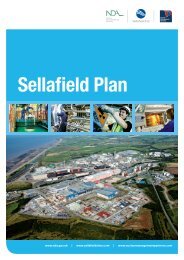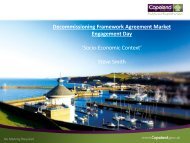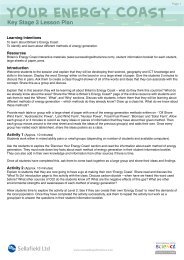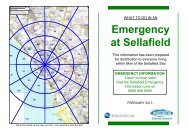Annual Report for 2010/11 and Forward Programme - Sellafield Ltd
Annual Report for 2010/11 and Forward Programme - Sellafield Ltd
Annual Report for 2010/11 and Forward Programme - Sellafield Ltd
You also want an ePaper? Increase the reach of your titles
YUMPU automatically turns print PDFs into web optimized ePapers that Google loves.
4. DISCUSSIONThe work reported here consists of two aspects related to airborne survey detection ofradioactive particles on the beaches around <strong>Sellafield</strong>, as a continuation of an earlier phase ofwork (S<strong>and</strong>erson & Cresswell <strong>2010</strong>). The earlier work used Monte Carlo simulationapproaches to determine detection limits <strong>for</strong> different survey parameters in natural radiationenvironments typical of the West Cumbrian coastline. The work reported here presentsassessments of the impact of dispersed 137 Cs backgrounds on detection limits, <strong>and</strong> theresponse to the particles already recovered from the beaches.4.1 137 Cs backgroundsPrevious airborne <strong>and</strong> ground based surveys have demonstrated that there are, in severalplaces, background levels of 137 Cs along the coastline of West Cumbria. On estuarine saltmarshes, where fine silt particles which readily sorb 137 Cs accumulate these backgroundlevels are very high. On s<strong>and</strong> <strong>and</strong> gravel beaches it is not expected that the 137 Cs containingsilts would accumulate, <strong>and</strong> background levels here are much lower. In some locations, inparticular in the vicinity of the <strong>Sellafield</strong> <strong>and</strong> Drigg sites, radiation originating from areasbehind the beach is a significant contribution to the 137 Cs background observed from anairborne survey.Detailed ground based surveys of the beaches of West Cumbria have shown that 137 Cs hasaccumulated in patches of several metre dimensions, <strong>and</strong> samples from these have typicallyshown activity concentrations of up to 50 Bq kg -1 . The <strong>for</strong>m of the 137 Cs contamination isunknown, as is the depth profile of these patches of activity. For the purpose of this study, thedepth profile was assumed to be uni<strong>for</strong>m to 30cm. The impact on detection limits <strong>for</strong>individual patches of activity with concentrations of 50 Bq kg -1 , <strong>and</strong> areas where several suchpatches are present, have been determined along with uni<strong>for</strong>m activity distributions.For activity distributions with uni<strong>for</strong>m concentrations over areas that exceed 3-4 times thefield of view of the detector, <strong>and</strong> high density of patches of activity over similar areas, thelimits of detection <strong>for</strong> 137 Cs particles is only slightly increased by approximately the sameamount as observed in the previous phase of work with the change from a medium to highnatural background. The significance, defined as the ratio of net counts to the uncertainty, ofmeasurements over sources of different strengths <strong>and</strong> distributions have been calculated.Interpolation from these calculated values allows detection limits based on a significance ofeither 2 or 3 to be determined. This has been done <strong>for</strong> three survey parameters; a “rapid”survey at 75m ground clearance <strong>and</strong> 75 knots, a “low <strong>and</strong> slow” survey at 15m groundclearance <strong>and</strong> 15 knots, <strong>and</strong> a very slow survey at 15m <strong>and</strong> 4 knots. These are given in Table4.1 <strong>for</strong> the medium natural background <strong>and</strong> the highest 137 Cs background considered here.The earlier work noted that reducing the ground clearance below 15m would significantlyincrease full energy peak count rates, with a corresponding reduction in detection limits,although the full simulation of the spectra <strong>for</strong> these heights have not been conducted. Thesedetection limits assume a data analysis algorithm that can determine trends in the radiationsignal over time, such as the background change alarm criteria based on predicted signalsused by Nuvia or the filtered differential analysis approach (Cresswell & S<strong>and</strong>erson 2009), orspatially using multiple measurements from different survey lines.For individual patches of activity of dimensions simulated here, the radiation observed from alow flying aircraft is indistinguishable from a single particle of similar total activity near the30


